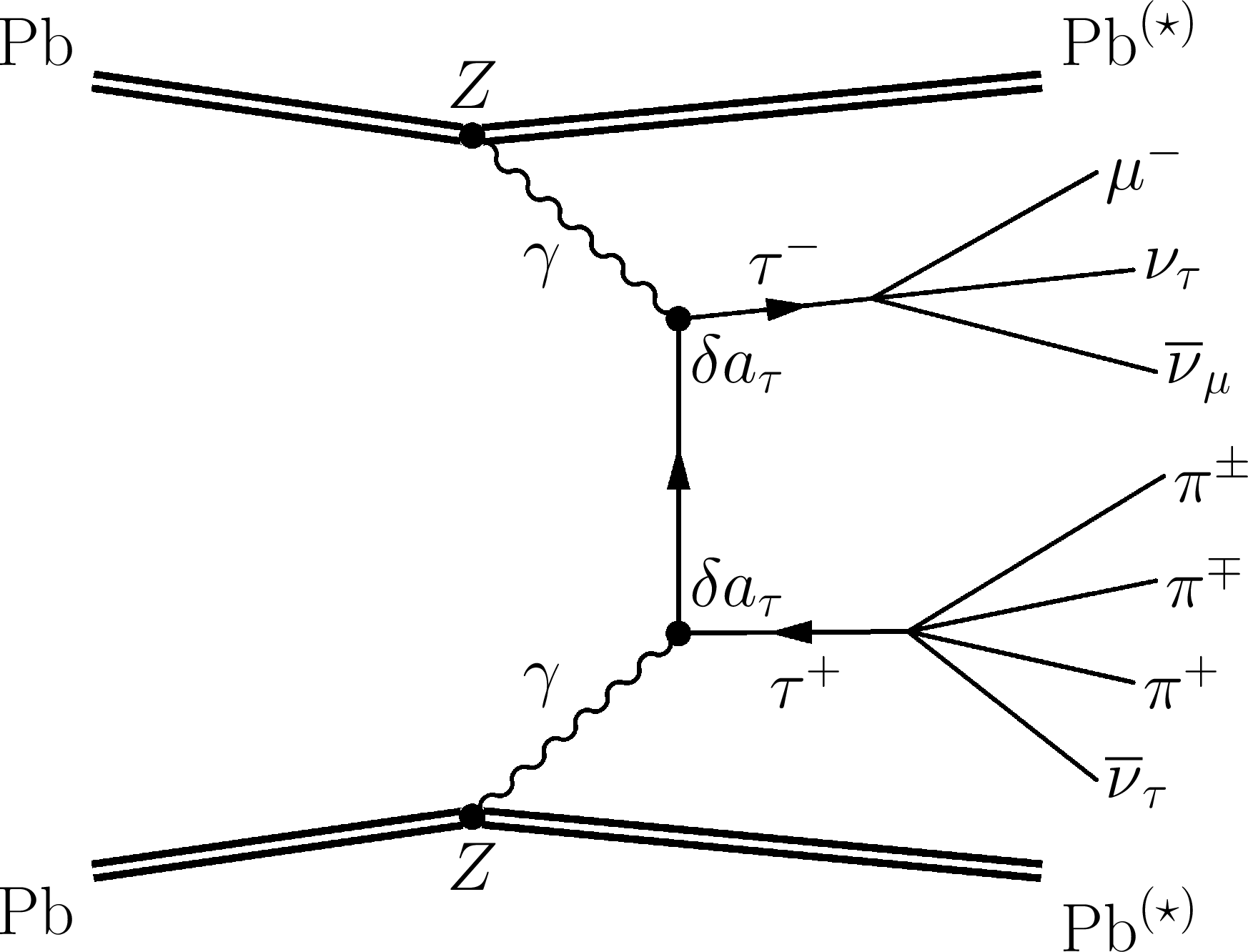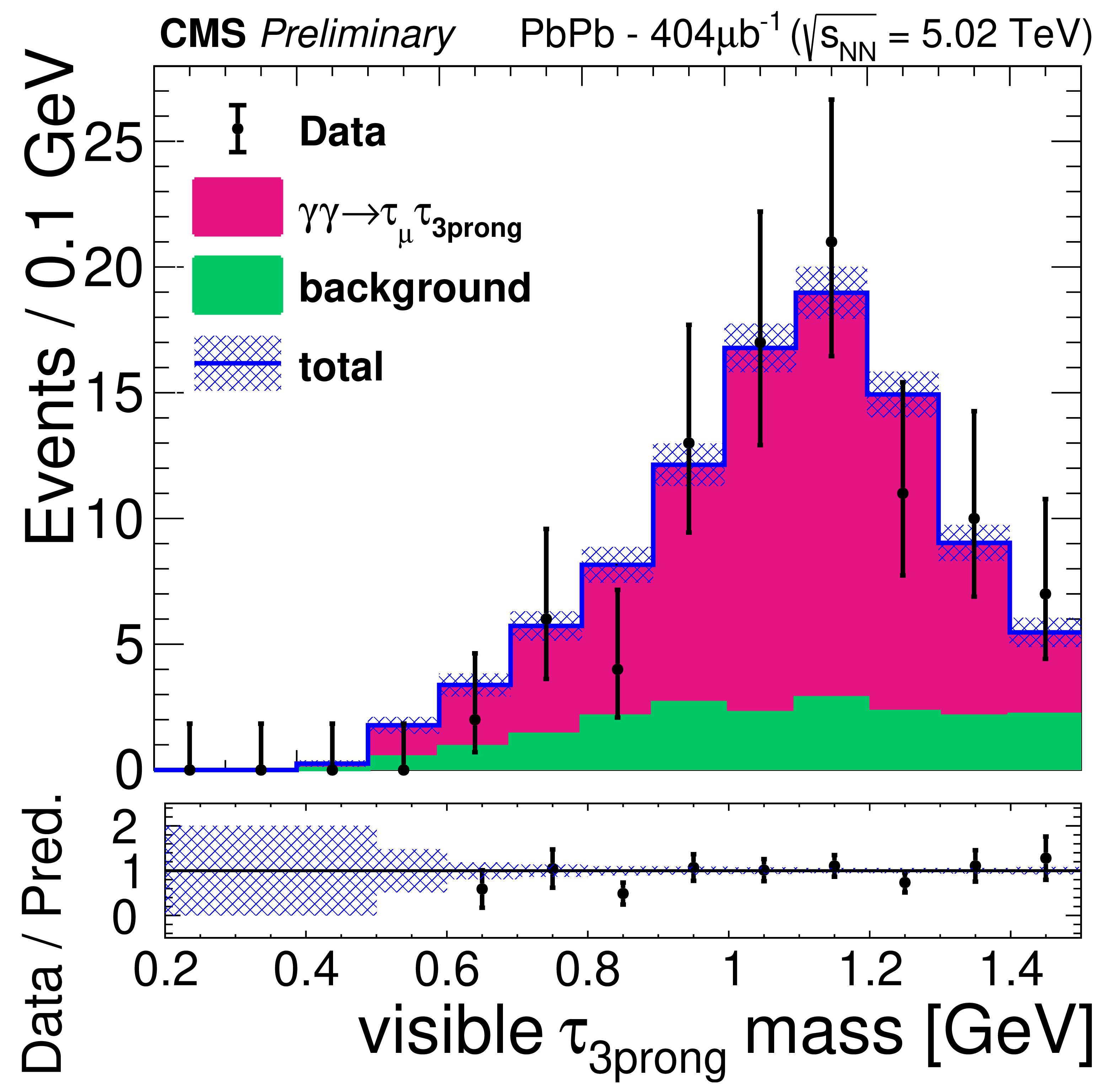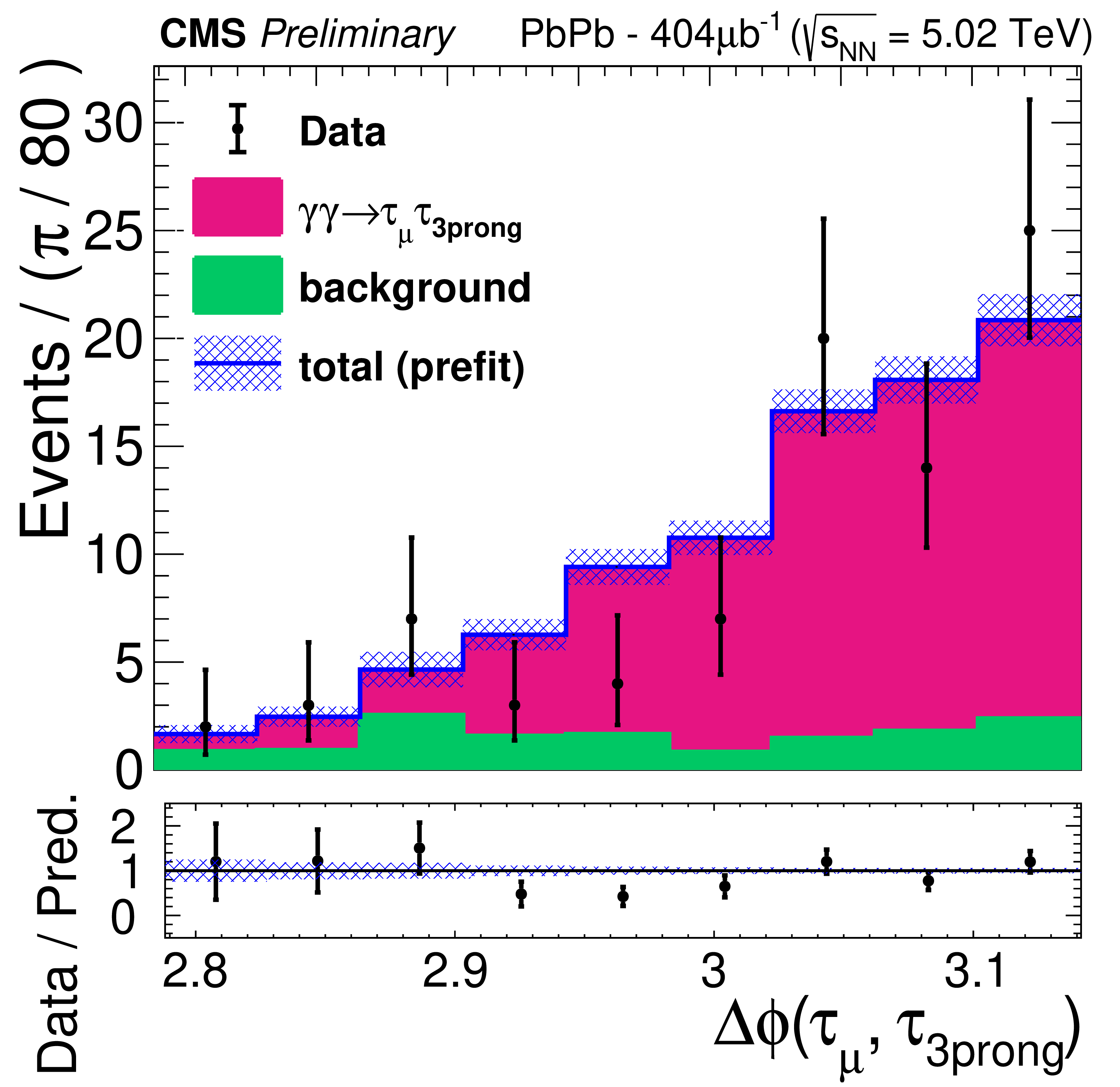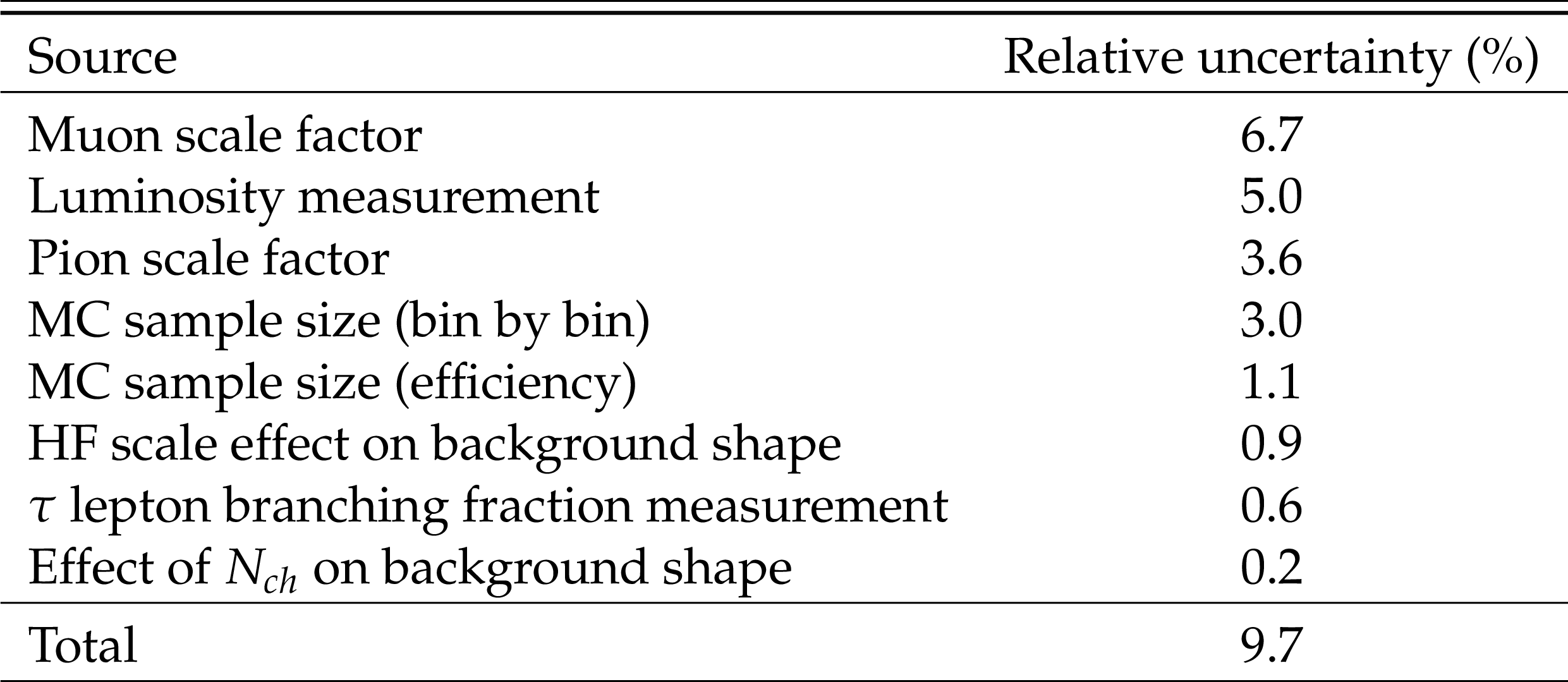

Compact Muon Solenoid
LHC, CERN
| CMS-PAS-HIN-21-009 | ||
| Observation of τ lepton pair production in ultraperipheral nucleus-nucleus collisions | ||
| CMS Collaboration | ||
| March 2022 | ||
| Abstract: The first observation of τ lepton pair production in ultraperipheral nucleus-nucleus collisions, a pure quantum electrodynamics (QED) process, is presented. The measurement is based on a data sample collected by the CMS experiment at a per nucleon center-of-mass energy of 5.02 TeV, and corresponding to an integrated luminosity of 404 μb−1. The photon-induced γγ→τ+τ− production is observed with a statistical significance of at least five standard deviations for τ+τ− events with a muon and three charged hadrons in the final state. The cross section is measured in a fiducial phase space region, and is found to be σ(γγ→τ+τ−)= 4.8 ± 0.6 (stat) ± 0.5 (syst) μb, in agreement with leading-order QED predictions. The measurement, produced with a fraction of the expected integrated luminosity of the LHC program, establishes the potential for a substantially more precise determination of the anomalous magnetic moment of the τ lepton, which is currently poorly constrained. | ||
|
Links:
CDS record (PDF) ;
Physics Briefing ;
CADI line (restricted) ;
These preliminary results are superseded in this paper, PRL 131 (2023) 151803. The superseded preliminary plots can be found here. |
||
| Figures | |

png pdf |
Figure 1:
Leading-order QED diagram (and charge conjugate) for the photoproduction of a pair of τ leptons γγ→τ+τ− in ultraperipheral PbPb collisions. The presence of γττ vertices gives sensitivity to the anomalous electromagnetic couplings of the τ lepton. A possible deviation of the anomalous magnetic moment δaτ is illustrated in each vertex. The τ leptons are reconstructed in an observed final state involving one muon (μ) and three charged particles assumed as pions (π), while neutrinos (ν) escape undetected. A potential electromagnetic excitation of the outgoing Pb ions is denoted by (∗). |

png pdf |
Figure 2:
Left: Transverse momentum of the muon originating from the τμ candidate. Middle: Invariant mass of the three pions forming the τ3prong candidate. Right: ττ invariant mass. In all plots, the signal component (pink histogram) is stacked on top of the background component (green histogram), considering their initial normalizations as described in the text. The total is displayed by a blue line and the shaded area shows the statistical uncertainty. The data are represented with black points and the uncertainty is statistical only. The lower panels show the ratios of data to the signal plus background prediction, and the shaded bands represent the statistical uncertainty. |

png pdf |
Figure 2-a:
Left: Transverse momentum of the muon originating from the τμ candidate. Middle: Invariant mass of the three pions forming the τ3prong candidate. Right: ττ invariant mass. In all plots, the signal component (pink histogram) is stacked on top of the background component (green histogram), considering their initial normalizations as described in the text. The total is displayed by a blue line and the shaded area shows the statistical uncertainty. The data are represented with black points and the uncertainty is statistical only. The lower panels show the ratios of data to the signal plus background prediction, and the shaded bands represent the statistical uncertainty. |

png pdf |
Figure 2-b:
Left: Transverse momentum of the muon originating from the τμ candidate. Middle: Invariant mass of the three pions forming the τ3prong candidate. Right: ττ invariant mass. In all plots, the signal component (pink histogram) is stacked on top of the background component (green histogram), considering their initial normalizations as described in the text. The total is displayed by a blue line and the shaded area shows the statistical uncertainty. The data are represented with black points and the uncertainty is statistical only. The lower panels show the ratios of data to the signal plus background prediction, and the shaded bands represent the statistical uncertainty. |

png pdf |
Figure 2-c:
Left: Transverse momentum of the muon originating from the τμ candidate. Middle: Invariant mass of the three pions forming the τ3prong candidate. Right: ττ invariant mass. In all plots, the signal component (pink histogram) is stacked on top of the background component (green histogram), considering their initial normalizations as described in the text. The total is displayed by a blue line and the shaded area shows the statistical uncertainty. The data are represented with black points and the uncertainty is statistical only. The lower panels show the ratios of data to the signal plus background prediction, and the shaded bands represent the statistical uncertainty. |

png pdf |
Figure 3:
Difference in azimuthal opening angle between the τμ and τ3prong candidates. The data are represented by the points with the vertical bars showing the statistical uncertainties. The signal (background) contribution is given by the pink (green) histogram, after the application of the fit procedure. The total is displayed by a blue line and the shaded area shows the total uncertainty. The lower panel shows the ratio of data to the signal plus background prediction, and the shaded band represents the total uncertainty. |

png pdf |
Figure 4:
The cross section, σ(γγ→τ+τ−), measured in a fiducial phase space region at √sNN= 5.02 TeV. The theoretical predictions are computed with leading-order accuracy in QED and represented by the dark and light gray bands [3,4]. |

png pdf |
Figure A1:
Event display of a candidate γγ→τ+τ− event measured in PbPb UPC at CMS. The event is reconstructed as having a leptonic τ decay (red), τ→μνμντ, and a hadronic τ decay (yellow), τ→π±π∓π±ντ. |

png pdf |
Figure A2:
Initial agreement between the data and the signal and background models before the fit procedure is applied. Difference in azimuthal opening angle between the τμ and τ3prong candidates. The signal component (pink histogram) is stacked on top of the background component (green histogram), before the application of the fit procedure. The total is displayed by a blue line and the shaded area shows the statistical uncertainty. The data are represented by the points with the vertical bars showing the statistical uncertainties. The lower panel shows the ratios of data to the signal plus background prediction, and the shaded bands represent the statistical uncertainty. |

png pdf |
Figure A3:
Comparison of the constraints on aτ at 68% confidence level from this analysis (using the parametrization from Ref. [3]) and the DELPHI experiment at LEP. The projection to the integrated PbPb luminosity expected from the High-Luminosity LHC program is included. For the latter, we foresee a ≲4 ( < 2)% systematic (statistical) uncertainty with the improvements originating from lepton and tracking reconstruction, and the knowledge of the luminosity. |
| Tables | |

png pdf |
Table 1:
Summary of the event selection, which coincides with the definition of the fiducial phase space region for the {\sigma ({\gamma {}\gamma \to {\tau^{+} {}\tau^{-} {}}})} measurement. |

png pdf |
Table 2:
Postfit contributions to the systematic uncertainty of the {\sigma ({\gamma {}\gamma \to {\tau^{+} {}\tau^{-} {}}})} measurement, in percent. The last row gives the sum in quadrature of all components. |
| Summary |
| In summary, the first observation of \tau lepton pair production in ultraperipheral nucleus-nucleus collisions is reported. Events with a final state of one muon and three charged particles identified as pions are reconstructed from a lead-lead data sample collected by the CMS experiment at {\sqrt {\smash [b]{s_{_{\mathrm {NN}}}}}} = 5.02 TeV in 2015, and corresponding to an integrated luminosity of 404 \mub^{-1}. The statistical significance of the signal relative to the background-only expectation is above five standard deviations. The cross section for the \gamma\gamma\tau\tau process, within a fiducial phase space region, is in agreement with predictions from quantum electrodynamics at leading-order accuracy. This measurement introduces a novel experimental strategy using heavy ion collisions already recorded by the LHC, which is expected, with the incorporation of additional data, to surpass the precision on the \tau magnetic moment attained previously at lepton-lepton colliders. Using the measured cross section and its corresponding uncertainties, we estimate a limit of (-2.4 < a_\tau< 1.7) \times 10^{-2} with 68% confidence level. |
| References | ||||
| 1 | P. A. Steinberg for the ALICE, ATLAS, CMS, LHCb, and STAR Collaborations | Ultraperipheral collisions at RHIC and the LHC | NP A 1005 (2021) 122007 | |
| 2 | F. del Aguila, F. Cornet, and J. I. Illana | The possibility of using a large heavy ion collider for measuring the electromagnetic properties of the \tau lepton | PLB 271 (1991) 256 | |
| 3 | L. Beresford and J. Liu | New physics and \tau g-2 using LHC heavy ion collisions | PRD 102 (2020) 113008 | 1908.05180 |
| 4 | M. Dyndal, M. Klusek-Gawenda, M. Schott, and A. Szczurek | Anomalous electromagnetic moments of \tau lepton in \gamma{}\gamma \to \tau\tau reaction in \mathrm{PbPb} collisions at the LHC | PLB 809 (2020) 135682 | 2002.05503 |
| 5 | R. H. Parker et al. | Measurement of the fine-structure constant as a test of the standard model | Science 360 (2018) 191 | 1812.04130 |
| 6 | L. Morel, Z. Yao, P. Clad\'e, and S. Guellati-Kh\'elifa | Determination of the fine-structure constant with an accuracy of 81 parts per trillion | Nature 588 (2020), no. 7836, 61 | |
| 7 | Muon g-2 Collaboration | Measurement of the positive muon anomalous magnetic moment to 0.46 ppm | PRL 126 (2021) 141801 | 2104.03281 |
| 8 | T. Aoyama et al. | The anomalous magnetic moment of the muon in the Standard Model | PR 887 (2020) 1 | 2006.04822 |
| 9 | M. Passera | Precise mass-dependent QED contributions to leptonic g-2 at order \alpha^2 and \alpha^3 | PRD 75 (2007) 013002 | hep-ph/0606174 |
| 10 | S. Eidelman and M. Passera | Theory of the \tau lepton anomalous magnetic moment | MPLA 22 (2007) 159 | hep-ph/0701260 |
| 11 | DELPHI Collaboration | Study of \tau pair production in photon-photon collisions at LEP and limits on the anomalous electromagnetic moments of the \tau lepton | EPJC 35 (2004) 159 | hep-ex/0406010 |
| 12 | BaBar Collaboration | Evidence for an excess of \bar{B} \to D^{(*)} \tau^-\bar{\nu}_\tau decays | PRL 109 (2012) 101802 | 1205.5442 |
| 13 | BaBar Collaboration | Measurement of an excess of \bar{B} \to D^{(*)}\tau^- \bar{\nu}_\tau decays and implications for charged Higgs bosons | PRD 88 (2013) 072012 | 1303.0571 |
| 14 | Belle Collaboration | Measurement of the branching ratio of \bar{B} \to D^{(\ast)} \tau^- \bar{\nu}_\tau relative to \bar{B} \to D^{(\ast)} \ell^- \bar{\nu}_\ell decays with hadronic tagging at Belle | PRD 92 (2015) 072014 | 1507.03233 |
| 15 | Belle Collaboration | Measurement of the branching ratio of \bar{B}^0 \rightarrow D^{*+} \tau^- \bar{\nu}_{\tau} relative to \bar{B}^0 \rightarrow D^{*+} \ell^- \bar{\nu}_{\ell} decays with a semileptonic tagging method | PRD 94 (2016) 072007 | 1607.07923 |
| 16 | Belle Collaboration | Measurement of the \tau lepton polarization and R(D^*) in the decay \bar{B} \to D^* \tau^- \bar{\nu}_\tau | PRL 118 (2017) 211801 | 1612.00529 |
| 17 | Belle Collaboration | Measurement of the \tau lepton polarization and R(D^*) in the decay \bar{B} \rightarrow D^* \tau^- \bar{\nu}_\tau with one-prong hadronic \tau decays at Belle | PRD 97 (2018) 012004 | 1709.00129 |
| 18 | Belle Collaboration | Measurement of \mathcal{R}(D) and \mathcal{R}(D^*) with a semileptonic tagging method | PRL 124 (2020) 161803 | 1910.05864 |
| 19 | LHCb Collaboration | Measurement of the ratio of branching fractions \mathcal{B}(\bar{B}^0 \to D^{*+}\tau^{-}\bar{\nu}_{\tau})/\mathcal{B}(\bar{B}^0 \to D^{*+}\mu^{-}\bar{\nu}_{\mu}) | PRL 115 (2015) 111803 | 1506.08614 |
| 20 | LHCb Collaboration | Measurement of the ratio of the B^0 \to D^{*-} \tau^+ \nu_{\tau} and B^0 \to D^{*-} \mu^+ \nu_{\mu} branching fractions using three-prong \tau -lepton decays | PRL 120 (2018) 171802 | 1708.08856 |
| 21 | LHCb Collaboration | Measurement of the ratio of branching fractions \mathcal{B}(B_c^+ \to J/\psi\tau^+\nu_\tau) / \mathcal{B}(B_c^+ \to J/\psi\mu^+\nu_\mu) | PRL 120 (2018) 121801 | 1711.05623 |
| 22 | Belle Collaboration | Lepton-flavor-dependent angular analysis of B\to K^\ast \ell^+\ell^- | PRL 118 (2017) 111801 | 1612.05014 |
| 23 | LHCb Collaboration | Measurement of form-factor-independent observables in the decay B^{0} \to K^{*0} \mu^+ \mu^- | PRL 111 (2013) 191801 | 1308.1707 |
| 24 | LHCb Collaboration | Differential branching fractions and isospin asymmetries of B \to K^{(*)} \mu^+ \mu^- decays | JHEP 06 (2014) 133 | 1403.8044 |
| 25 | LHCb Collaboration | Test of lepton universality using B^{+}\rightarrow K^{+}\ell^{+}\ell^{-} decays | PRL 113 (2014) 151601 | 1406.6482 |
| 26 | LHCb Collaboration | Angular analysis of the B^{0} \to K^{*0} \mu^{+} \mu^{-} decay using 3 fb ^{-1} of integrated luminosity | JHEP 02 (2016) 104 | 1512.04442 |
| 27 | LHCb Collaboration | Angular analysis and differential branching fraction of the decay B^0_s\to\phi\mu^+\mu^- | JHEP 09 (2015) 179 | 1506.08777 |
| 28 | LHCb Collaboration | Test of lepton universality with B^{0} \rightarrow K^{*0}\ell^{+}\ell^{-} decays | JHEP 08 (2017) 055 | 1705.05802 |
| 29 | LHCb Collaboration | Search for lepton-universality violation in B^+\to K^+\ell^+\ell^- decays | PRL 122 (2019) 191801 | 1903.09252 |
| 30 | CMS Collaboration | The CMS Experiment at the CERN LHC | JINST 3 (2008) S08004 | CMS-00-001 |
| 31 | CMS Collaboration | Performance of the CMS level-1 trigger in proton-proton collisions at \sqrt{s} = 13 TeV | JINST 15 (2020) P10017 | CMS-TRG-17-001 2006.10165 |
| 32 | CMS Collaboration | The CMS trigger system | JINST 12 (2017) P01020 | CMS-TRG-12-001 1609.02366 |
| 33 | CMS Collaboration | Performance of electron reconstruction and selection with the CMS detector in proton-proton collisions at \sqrt{s} = 8 TeV | JINST 10 (2015) P06005 | CMS-EGM-13-001 1502.02701 |
| 34 | CMS Collaboration | Performance of the CMS muon detector and muon reconstruction with proton-proton collisions at \sqrt{s}= 13 TeV | JINST 13 (2018) P06015 | CMS-MUO-16-001 1804.04528 |
| 35 | CMS Collaboration | Performance of photon reconstruction and identification with the CMS detector in proton-proton collisions at \sqrt{s}= 8 TeV | JINST 10 (2015) P08010 | CMS-EGM-14-001 1502.02702 |
| 36 | CMS Collaboration | Description and performance of track and primary-vertex reconstruction with the CMS tracker | JINST 9 (2014) P10009 | CMS-TRK-11-001 1405.6569 |
| 37 | CMS Collaboration | Particle-flow reconstruction and global event description with the CMS detector | JINST 12 (2017) P10003 | CMS-PRF-14-001 1706.04965 |
| 38 | CMS Collaboration | Performance of reconstruction and identification of \tau leptons decaying to hadrons and \nu_\tau in pp collisions at \sqrt{s}= 13 TeV | JINST 13 (2018) P10005 | CMS-TAU-16-003 1809.02816 |
| 39 | CMS Collaboration | Jet energy scale and resolution in the CMS experiment in pp collisions at 8 TeV | JINST 12 (2017) P02014 | CMS-JME-13-004 1607.03663 |
| 40 | CMS Collaboration | Performance of missing transverse momentum reconstruction in proton-proton collisions at \sqrt{s} = 13 TeV using the CMS detector | JINST 14 (2019) P07004 | CMS-JME-17-001 1903.06078 |
| 41 | J. Alwall et al. | The automated computation of tree-level and next-to-leading order differential cross sections, and their matching to parton shower simulations | JHEP 07 (2014) 079 | 1405.0301 |
| 42 | T. Sjostrand et al. | An introduction to PYTHIA 8.2 | CPC 191 (2015) 159 | 1410.3012 |
| 43 | GEANT4 Collaboration | GEANT4--a simulation toolkit | NIMA 506 (2003) 250 | |
| 44 | CMS Collaboration | Measurement of Tracking Efficiency | CMS-PAS-CMS-PAS-TRK-10-002 | |
| 45 | CMS Collaboration | Measurement of exclusive \Upsilon photoproduction from protons in pPb collisions at \sqrt{\smash[b]{s_{_{\mathrm{NN}}}}}= 5.02 TeV | EPJC 79 (2019) 277 | CMS-FSQ-13-009 1809.11080 |
| 46 | Particle Data Group Collaboration | Review of Particle Physics | PTEP 2020 (2020) 083C01 | |
| 47 | CMS Collaboration | Precision luminosity measurement in proton-proton collisions at \sqrt{s} = 13 TeV in 2015 and 2016 at CMS | EPJC 81 (2021) 800 | CMS-LUM-17-003 2104.01927 |
| 48 | CMS Collaboration | Evidence for light-by-light scattering and searches for axion-like particles in ultraperipheral PbPb collisions at \sqrt{s_\mathrm{NN}} = 5.02 TeV | PLB 797 (2019) 134826 | CMS-FSQ-16-012 1810.04602 |

|
Compact Muon Solenoid LHC, CERN |

|

|

|

|

|

|